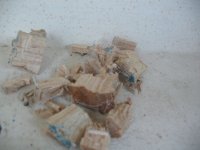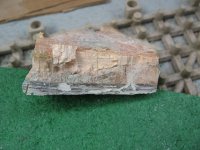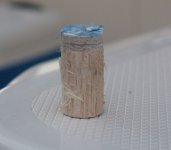wanna-be":35r91tdm said:
Hi guys have 3/8 hole in transom came with boat after removing transducer along with 5 screw holes what is best method to seal them up for carefree future? thanx
Hi there, wann-be (sounds like you ARE now

)
Good on you for being interested in doing a good job vs. just globbing on some silicone (my nemesis

) The short story is to fill them with thickened epoxy, and then paint or gelcoat over. More detail:
Here is how I would handle those holes (presuming you are not re-using them).
1) Remove all traces of caulking.
2) Slightly over-drill holes, and then either look at the "shavings" on the drill bit or pick out some additional material with a dental pick or the like. I look this over carefully to determine if it is wet or damp. If it's wet it will be fairly obvious; damp can be a little sneakier. I like to take a bit of the core and squeeze it between two fingers, then see if it leaves any moisture on them. When drilling, running the drill bit backwards first will help to avoid gelcoat chip out. Or I chamfer it a bit first with a chamfering bit. (You can tape over the area when making new holes; I don't find this works as well on existing holes.)
3) I remove any wet or damp core, back to dry, (usually light-colored and almost "crisp") core. If this gets extensive, post back in the thread and we can go from there. Presuming things are basically dry, we can move forward. I also pick out a bit of additional material to make it so the fill is larger in diameter than the hole. This adds an element of "keying" the epoxy in place (although it already makes very good secondary bonds).
4) Vacuum and then wash the hole with solvent (I use denatured alcohol, you can also use acetone)
5) Cover the hole and out around it with blue tape, then take an Exacto knife and cut out hole again. If there is a place where epoxy even might
consider droozling down, cover that too. Put some spare pieces of tape around the area, just stuck up so you can grab them with sticky gloves without getting it on anything.
6) Now I get my epoxy gear together. Suit, gloves, respirator (if using colloidal silica filler), more gloves, mixing stick, filler, small tubes, syringe, acid brush, pipe cleaner, toothpick or sliver of water jug, etc. You want to keep epoxy off your skin.
7) Filling a "blind" hole is always tricky. Blind meaning that there is no second hole for air to come out of. If you just fill from the opening you'll trap air in there and that's not good. So the objective is to fill from the back to the front of the hole, which will push the air out ahead of the epoxy. Depending on the depth, I either use just a syringe or I take some electrical shrink tubing that I can fit on the end of the syringe (or a straw). I have used a baggie with the corner clipped, but that's hard to get into the back of a small hole.
8 ) Back to the repair. I mix up a bit of neat (just resin and hardener) epoxy. Then I soak the "walls" of the hole with it. I use a pipe cleaner on a small hole, or an acid brush (sometimes trimmed with scissors). Next I thicken the rest of it (in the cup) with colloidal silica or some other structural filler. If it's a hole with a horizontal top, I keep it somewhat soupy, maybe like thin catsup; on a hole with a vertical wall, I will mix it a bit thicker, like mayonnaise. But not as thick as peanut butter. Then I load the syringe (with thinner stuff you can suck it up; with thicker you have to load it in with a small spatula of some type or a stick, then put the plunger in. I tip it up like in the doctor shows and purge the air as well as I can. Then I get the tip (or tube that I have on the tip) at the back of the hole and slowly start filling it. The air should come out ahead of the syringe tip. I pull the syringe slowly out as I go, so epoxy fills the hole left by the syringe. Then I spatula in a bit for good measure if I need to, and slap a piece of tape over it all (making it flattish, not too humped).
9) If I possibly can, I get back to the hole during the "green" stage of the epoxy (still rubbery) and then I can "slice" it off nice and flat with a chisel.
Notes on finishing:
1) Epoxy does not resist UV well, so it needs to be covered by something on the surface.
2) If your boat is bottom painted, you can just paint over the flat repair with bottom paint (and barrier coat if you have that already).
3) If it is gelcoated, you may want to re-gelcoat. There are a couple of schools of thought on this: One is that (polyester) gelcoat will never stick to epoxy. Another (see WEST article) is that gelcoat will stick to well-cured epoxy. In speaking with WEST on the phone they advised to make sure not to mix the batch hardener rich if you are going to gelcoat it (that said, it still needs to be properly measured; they are talking hairs of difference here). "Free" hardener is apparently what causes the problems. A third option (which I just learned about and am doing test panels with at the moment) is to use System Three's SB-112 epoxy, and then gelcoat over it within 48 hours. That can just be a topcoat; you don't have to do the repair with it. I guess let's see what you have on your boat currently before going further on these lines?
Sunbeam :hot



